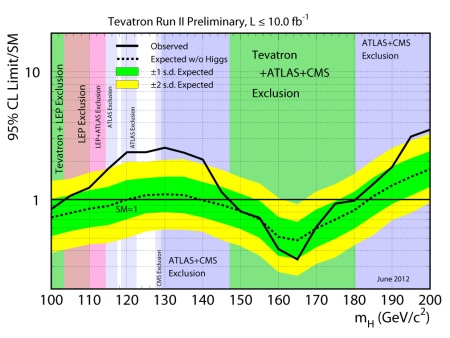
An unspectacular representation of ‘the Higgs result’. Slightly more events of a particular kind have been seen when particles collide with a particular energy. Picture from DOE Tevatron.
My last course in particle physics at University represented the high water-mark of my understanding of the subject. But I was already struggling. So in the matter of the Higgs discovery my scientific qualifications, offer me only the slightest of advantages.
Fortunately the man who was responsible for what understanding I once possessed, David Bailin, responded to my plea for help:
As you say, the Higgs mechanism gives masses to all (truly elementary) particles, … but that certainly does not account for most of the mass of ordinary matter like us. Most of the mass of neutrons and protons derives from non-perturbative strong interaction effects in the gluons (and quark-anti-quark pairs) that bind the valence quarks in the nucleon.
The key words here are ‘truly elementary‘. As I understand this, the Higgs mechanism is responsible for all the mass of electrons, muons, and quarks. But it is not responsible for all – or even most – of the mass of composite particles such mesons, protons and neutrons (glossary here). I think this is an interesting subtlety to the more generally “Higgs gives mass” simple story that has been widely reported. This simple story is true in that the quark–quark interactions that give rise to most of the mass of ordinary matter would not have got started if the Higgs field had not given some initial mass.
The idea is that as the Universe cooled, the Higgs field first gave truly elementary particles their initial mass, and then later on these particles interacted and acquired the bulk of their additional mass as a consequence.
Is that clearer now?
===========
Full Quote from David Bailin
As you say, the Higgs mechanism gives masses to all (truly elementary) particles, except those like the photon, gluons (and graviton) that are protected by an unbroken gauge symmetry. But that certainly does not account for most of the mass of ordinary matter like us. Most of the mass of neutrons and protons derives from non-perturbative strong interaction effects in the gluons (and quark-anti-quark pairs) that bind the valence quarks in the nucleon. That’s what the lattice QCD people have spent so long and so much money trying to compute. The nucleon masses would hardly change even if there was no Higgs effect. Gravity is coupled to anything with a non-zero energy momentum tensor, and that certainly includes the “condensate” in the nucleons, as well as the Higgs field.
July 16, 2012 at 11:52 am |
Michael,
I don’t think the “simple story”, as you have told it, is true! The quark-quark interactions (not to mention the self-interaction of the gluons) that give rise to most of the mass of ordinary matter are mediated by gluons which only “see” the colour of the quarks (and gluons), not their mass. As I said, the lattice QCD people are trying to compute the hadron spectrum (mesonic first, but baryonic later), and they certainly don’t need, or even use, the Higgs-mechanism generated masses of the quarks. (I’m not absolutely certain about the not using; since the quark-mass contribution is less than 1% of the nucleon mass and I doubt that they can calculate even to 10% accuracy, I believe what I say is correct. You could ask Simon Duane: he was a lattice person once, I seem to recall.)
Best wishes
David
July 16, 2012 at 12:43 pm |
David
I will check.
M